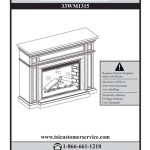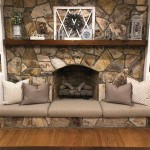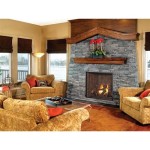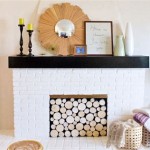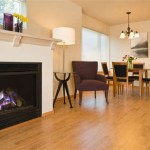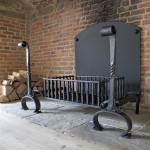Outdoor Rock Fireplace Plans: A Comprehensive Guide
An outdoor rock fireplace provides a focal point for any backyard or patio, offering warmth, ambiance, and a rustic aesthetic appeal. The construction of such a feature necessitates careful planning, material selection, and adherence to safety guidelines. This article explores various aspects of outdoor rock fireplace plans, encompassing design considerations, construction steps, and maintenance practices.
Planning and Design Considerations
Before commencing the construction of an outdoor rock fireplace, thorough planning is crucial. This phase involves assessing the available space, determining the desired style, and ensuring compliance with local building codes and regulations.
The first step involves evaluating the available space. The dimensions of the fireplace, including the hearth, firebox, and chimney, must be carefully considered in relation to the surrounding area. A larger space allows for a grander design, while a smaller area necessitates a more compact structure. Factors such as proximity to property lines, trees, and other structures must also be taken into account.
Selecting the appropriate design is paramount. Outdoor rock fireplaces can range from simple, rustic structures to elaborate, contemporary designs. The design should complement the existing architecture of the home and the overall landscaping of the property. Considerations include the shape of the firebox, the height of the chimney, and the type of rock used.
Adhering to local building codes and regulations is non-negotiable. Many municipalities have specific requirements regarding fireplace construction, including setback distances from property lines, chimney height restrictions, and emissions standards. Obtaining the necessary permits before starting construction is essential to avoid potential fines and delays.
Furthermore, safety is a paramount concern during the planning phase. The fireplace should be located away from flammable materials, such as trees, fences, and overhanging structures. A fire-resistant hearth should extend beyond the firebox to protect the surrounding ground from sparks and embers. The chimney should be tall enough to ensure proper draft and prevent smoke from blowing back into the seating area.
Budgetary considerations also play a significant role in the planning process. The cost of materials, labor, and permits can vary widely depending on the size and complexity of the design. A detailed budget should be established before starting construction to avoid unexpected expenses.
The choice of fuel should be another decision. Wood-burning fireplaces are the most traditional option, but they require a regular supply of firewood and produce smoke. Gas-burning fireplaces are a cleaner and more convenient alternative, but they necessitate a gas line connection. The choice depends on personal preferences and local regulations.
Construction Steps
The construction of an outdoor rock fireplace involves several distinct steps, from laying the foundation to building the chimney. Each step requires careful attention to detail and adherence to established construction techniques.
The foundation is the most critical element of any fireplace. It must be strong and stable enough to support the weight of the entire structure. A concrete slab is the most common type of foundation for outdoor fireplaces. The slab should be reinforced with steel rebar to prevent cracking and settling. The dimensions of the slab should be slightly larger than the base of the fireplace to provide adequate support.
The firebox is the heart of the fireplace, where the fire is contained. It should be constructed from fire-resistant materials, such as firebrick or refractory concrete. The firebox should be properly insulated to prevent heat from transferring to the surrounding structure. The size and shape of the firebox should be appropriate for the intended use of the fireplace. A larger firebox can accommodate larger fires, while a smaller firebox is more efficient for smaller flames.
The chimney is responsible for venting smoke and gases away from the seating area. It should be tall enough to ensure proper draft and prevent smoke from blowing back into the area. The chimney should be constructed from fire-resistant materials, such as brick, stone, or metal. The inside of the chimney should be lined with a flue to protect the surrounding structure from heat and corrosion. The chimney cap prevents rain and debris from entering the chimney and causing damage.
The rock veneer provides the aesthetic appeal of the fireplace. The type of rock used can vary widely depending on personal preferences and the availability of materials. Natural stone, such as fieldstone, limestone, and sandstone, is a popular choice for outdoor fireplaces. The rock veneer should be carefully mortared in place to create a strong and durable structure. The joints between the rocks should be filled with mortar to prevent water from seeping into the structure.
The hearth extends beyond the firebox and protects the surrounding ground from sparks and embers. It can be constructed from a variety of materials, such as brick, stone, or concrete. The hearth should be level and stable to provide a safe and comfortable seating area. The size of the hearth should be appropriate for the size of the fireplace and the intended use of the seating area.
Proper drainage is essential to prevent water from accumulating around the base of the fireplace. A drainage system should be installed to divert water away from the foundation. This can be achieved by grading the surrounding area or installing a French drain. A properly designed drainage system will help to prevent erosion and water damage.
Maintenance and Safety
Regular maintenance and adherence to safety guidelines are crucial for ensuring the longevity and safe operation of an outdoor rock fireplace.
Cleaning the fireplace regularly is essential for preventing the buildup of creosote and other debris. Creosote is a flammable substance that can accumulate in the chimney and firebox, increasing the risk of a chimney fire. The firebox should be cleaned after each use to remove ashes and unburned wood. The chimney should be inspected and cleaned annually by a qualified professional.
Inspecting the fireplace regularly for signs of damage is important for identifying and addressing potential problems before they become serious. Cracks in the firebox, crumbling mortar, and loose rocks should be repaired promptly. A damaged fireplace can be a safety hazard and should not be used until it has been repaired.
Using appropriate fuels is critical for safe and efficient operation. Only seasoned firewood should be used in wood-burning fireplaces. Green or wet wood produces more smoke and creosote. The type of gas used in gas-burning fireplaces should be appropriate for the type of burner. Using the wrong type of fuel can damage the fireplace and create a safety hazard.
Never leaving a fire unattended is a fundamental safety precaution. A fire should always be supervised by a responsible adult. Children and pets should be kept away from the fireplace to prevent accidents. A fire extinguisher or water hose should be readily available in case of an emergency.
Ensuring proper ventilation is important for preventing carbon monoxide poisoning. Carbon monoxide is a colorless, odorless gas that can be produced by burning fuel. Symptoms of carbon monoxide poisoning include headache, dizziness, and nausea. If anyone experiences these symptoms, the fire should be extinguished and the area should be ventilated immediately. A carbon monoxide detector should be installed near the fireplace to provide early warning of a potential hazard.
Storing firewood properly is important for preventing the spread of pests and diseases. Firewood should be stored in a dry, well-ventilated area away from the house. Stacking firewood neatly will help to prevent it from rotting and becoming infested with insects. Never bring firewood indoors, as this can introduce pests into the home.
Protecting the fireplace from the elements is important for extending its lifespan. A fireplace cover can be used to protect the fireplace from rain, snow, and wind. The cover should be made from a durable, water-resistant material. Applying a sealant to the rock veneer can help to prevent water from seeping into the structure and causing damage.
Regular maintenance and adherence to safety guidelines will ensure that an outdoor rock fireplace provides years of enjoyment and enhances the beauty of any outdoor space.

How To Build An Outdoor Stacked Stone Fireplace

Stonetutorials Living Stone Masonry

Stonetutorials Living Stone Masonry

Outdoor Fireplace Design Ideas Getting Cozy With 10 Designs Unilock

How To Plan For Building An Outdoor Fireplace
:max_bytes(150000):strip_icc()/milkpaint-286c9ee63b604ca1aaecac5233c8a3f3.jpg?strip=all)
10 Free Outdoor Fireplace Construction Plans

How To Build An Outdoor Fireplace Today S Creative Life

Custom Designed Fireplace Outdoor Plans Diy

Cabins Book A Guide To Building Your Own Nature Retreat Outdoor Fireplace Designs Plans

Outdoor Fireplaces Fire Pits Surrounds Landscape Architecture
Related Posts


